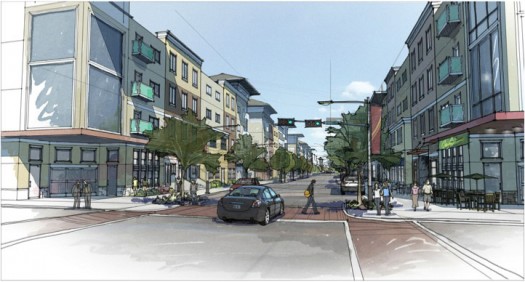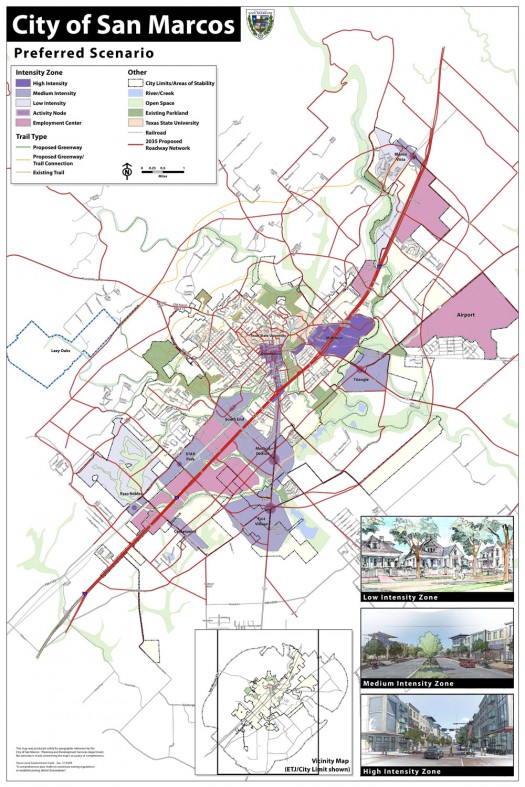A Placemaking Journal
Comp Planning Off the Beaten Path
I tend to take the road less traveled.
For whatever reason, conventional approaches have never interested me. And the process I came up with for my city’s comp plan was no different.
Why? Well, first off, conventionalism leads to….. “BORING!” (Yell it out like no one can hear you!)
San Marcos, Texas, where I serve as development director, is a quaint, progressive community of 50,000 with a university of 32,000 and expectations for Texas-sized creativity. Though tarnished by previous unpopular land use and transportation decisions, we’re best likened to a great grandfather’s old pocket-watch: Potentially good as new when cleaned up well and geared in the right direction.
That cleaning, in our case, rested on the creation of a new, transect-based comp plan, and the methodology we used to get there was, for us, an all-new way of doing things.
First and foremost, we listened. We spoke with the real community to find out what they liked about San Marcos. Rather than dwelling on the negative and defensive, we focused on positive things, however small, to work from. As we gathered up initial contributions, we created topics of conversation to take to the broader community, in essence crowdsourcing the ideas. This became our primary means of engagement and enabled the community along the way to “up vote” the good and “down vote” the bad as a collective group.

Next, the council appointed a diverse comp plan committee to oversee the process and ensure that things remained on track. They ranged from professors to avid bikers with a blend of professionals in the development industry. The first month out, the committee’s time was spent getting up to speed with sessions on urban design, planning, housing trends, environmental and utility needs. We brought in developers, inventors, Urbanists, environmentalists and utility specialists. We empowered through education.
Since our goal was a true, community-based plan, what better way of creating it than by city staff leading the process? These are the people who, ultimately, will be charged with implementing the document’s vision and goals, so I outsourced the staff’s daily work and we focused on comp planning. Yes, I had to use consultants in specialty areas, but the staff did all the hard work.
The focus of this comp plan was… FUN!! No one wants to come chill at a public meeting! People want to have fun and listen to local music and eat local food and drink local beers. They want to play with Legos and go to design rodeos (our version of a charrette), where you crown a king and queen at the end of the event. We are from Texas, where everyone ends every sentence with…. TEXAS! Knowing that people like to have fun, we started the plan off with a party and wrapped it up with a party. And all the time in between? We partied then too. It was the first real major celebration of community success I’ve seen in the city.
The technical aspects of the plan were uniquely created as well. After all the input and ideas were gathered, we held what we called the Growth and Preservation Allocation exercise (GPA). The GPA was done by printing large scaled maps in which we sized Legos to equal a certain number of units per acre (UPA). We studied the population trends and discovered we’d be planning for the next 33,000 people moving to San Marcos. We had a UPA bank where participants could swap their densities for a more compact city approach. To make sure the plans were feasible, we ran focal impact models of the scenarios coming out of the process.
There were several other cool tools used to ensure we were making educated and well developed decisions about future growth. One of my favorites was a watershed-based system to demonstrate development impacts per basin and sub-basins. The more I think about the inputs into the plan the more complete the final plan seems.
The community generated preferred scenario became the land use map that, together with an intensity table, now governs our land use decisions for the future. The plan is predictable and transparent so the community can understand and use it.
The pride the community has taken, in both the process and the plan, is one of a kind. With pride of ownership comes success and self worth. This holds true in our daily lives and in the community as a unit. The plan is rooted in best case scenarios and these have made way for creativity and an open flow of ideas.
Now that we’ve had all this fun, we now have an infographic-heavy, environmentally-responsible, transect-based comp plan intertwined with fiscally-viable, multimodal transportation networks, ready to bring to life. We are having the city departments write business plans that are comp plan-based. Their budgets are rooted in the goals of the comp plan and the CAPITAL Improvements Plan (CIP) is being aligned as well.
All of this hard work could not have been done without an innovative, community-based plan. Its meaningful input from real people is ultimately what helped the council support and adopt it. Unanimously.
Oh, and by the way, we did it in under a year. TEXAS!
–Matthew Lewis
Matthew Lewis is Development Director for the city of San Marcos, Texas.






